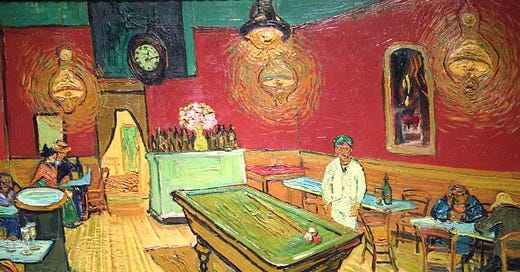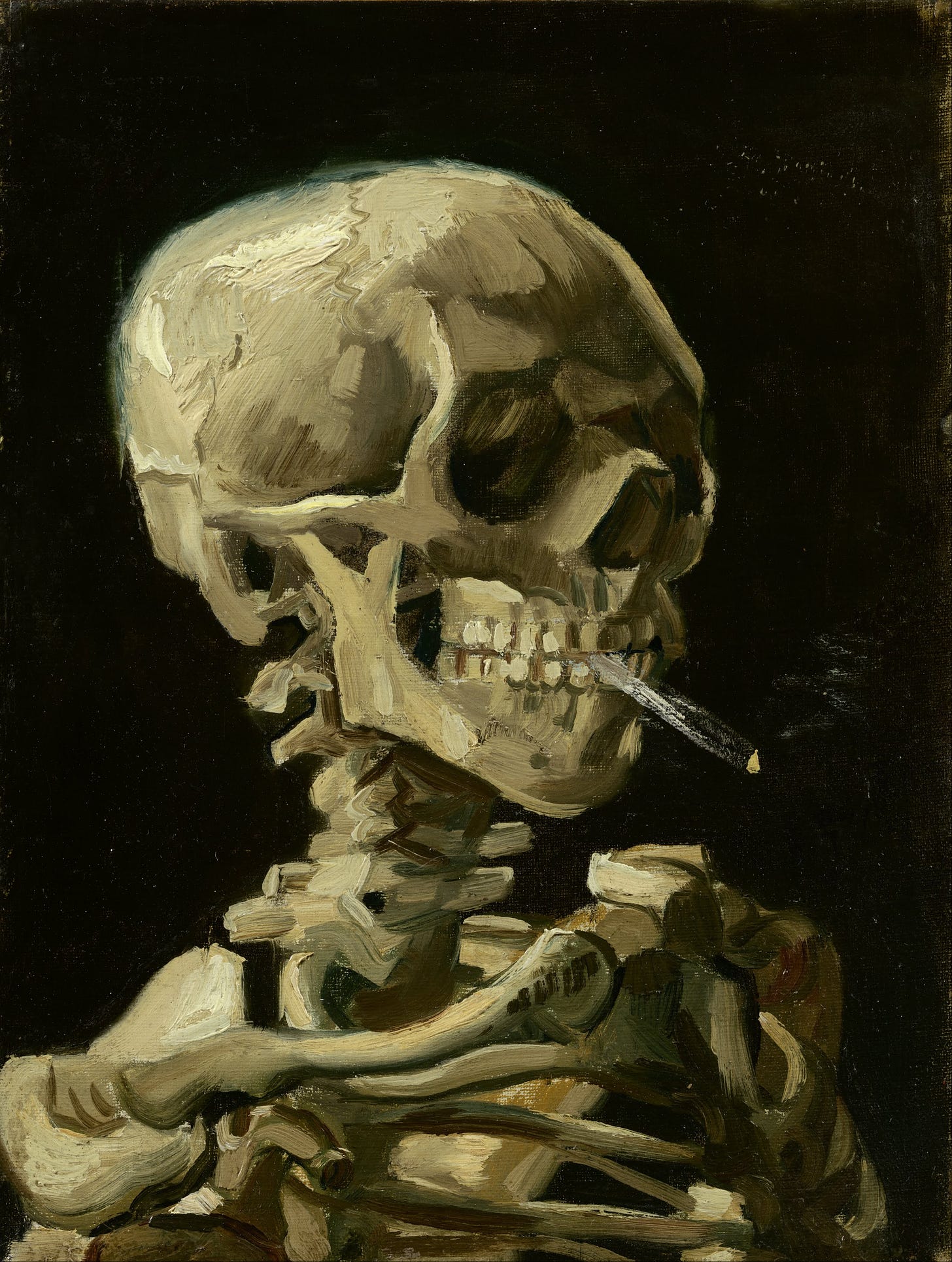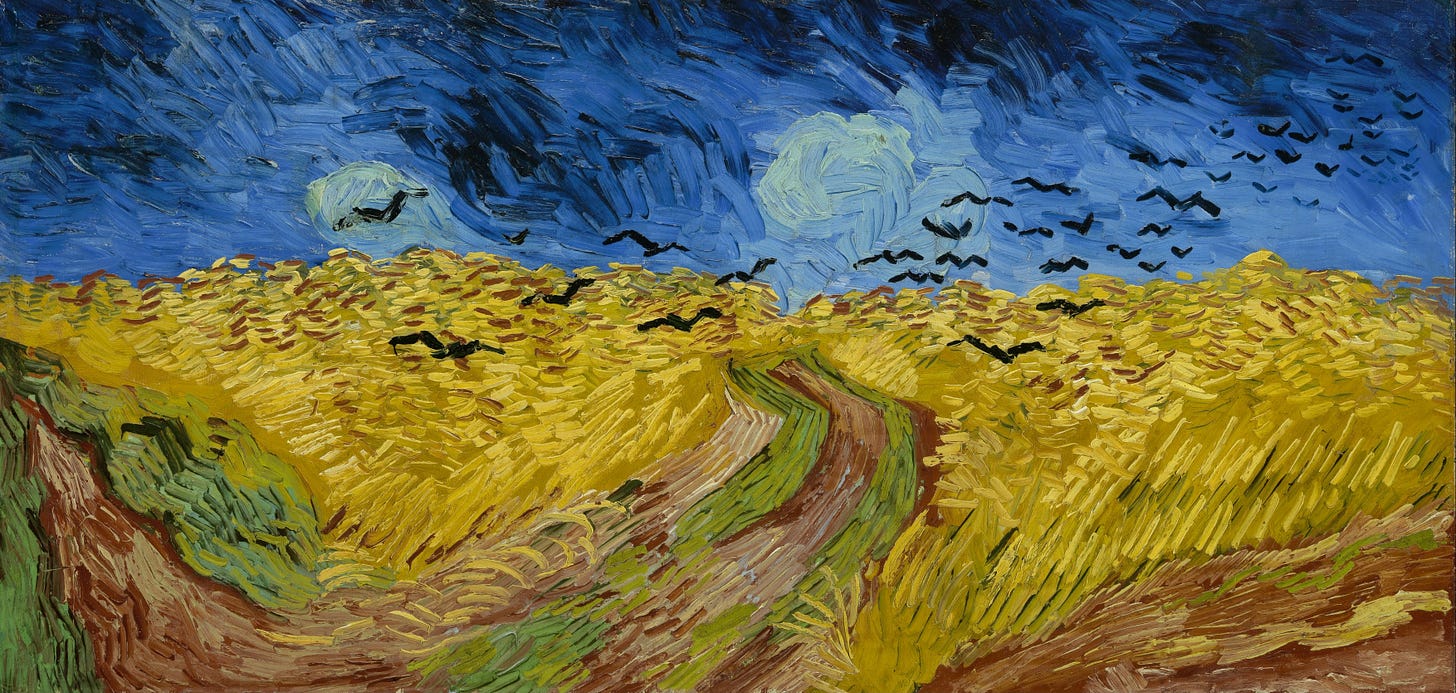Today marks the 170th anniversary of Vincent Van Gogh's birth, and as a Dutchman, I can't help but reflect on his life and work. Growing up, I was surrounded by popular Van Gogh images: the sunflowers, the starry night, and self-portraits. They were everywhere, on calendars, postcards, and even on mugs. It made it a challenge to appreciate the brilliance of his work beyond its commercialization.
I remember visiting the Van Gogh museum in Amsterdam as a child with my father. I guess I must have been ten or twelve years old. And now, diving deep into old memories locked up in my brain, I'm trying to dig up the first Van Gogh painting I stored in that grey database. Strangely, it's not very famous; it's the skull with a lit cigarette in its mouth. The museum describes it as a juvenile joke, painted by Vincent in early 1886 as a student at the art academy in Antwerp.
I wonder why this is the one that I remember. Could it be the 'juvenile' element that made the impression? I was a juvenile, but you can hardly call Vincent a juvenile at the age of 33, especially in a time when the concept of youth barely existed: in his time, you were supposed to dress, work, and behave as an adult at a far younger age than today. John Belushi, Evita Peron, and perhaps even Jesus died at 33, and they are not described as juvenile either (although some scenes of John Belushi may qualify).
But seeing Vincent's work through the eyes of a ten-year-old, I can imagine why this painting made an impression. There may be another element; my father was a doctor and art lover. Maybe that combination triggered his attention, and, always being a teacher, he may have taken some time to talk with me about the painting. Whatever it was, this painting is my oldest memory of Van Gogh. The Van Gogh museum commented that the artwork shows that Vincent had a good command of anatomy and added, "Drawing skeletons was a standard exercise at the academy, but painting them was not part of the curriculum. He must have made this painting at some other time, in between or after his lessons.”
Still searching in long-forgotten deep grey trenches of my brain, another memory pops up: the image of Van Gogh's potato eaters in one of my earliest history books. It was probably used to give us an idea of the poor living conditions in the Netherlands in the 19th century. Vincent painted it in the same period; unlike the smoking skull, this one is world-famous. I like the rawness and honesty of the painting, just as Van Gogh admired the honesty and rawness of the lives of the farmers' families. The image was unlike anything I had seen before, and it sparked at an early age a curiosity in me about Van Gogh's life and struggles. Then, in my high school days, I started to read more about him, and I became fascinated by his artistic journey and the challenges he faced.
I discovered the post-impressionists via two routes. One was through Van Gogh. The other is through my fascination for islands. The further away and the more insignificant they were, the more I was interested to discover all I could find about them, long before a google search command could give me more island information than I could process. Still, some 45 years later, I have loads of insignificant details in my head that were gems to me; the land area of Nauru, the date of discovery by the first Europeans of Rapa Nui, or the date, place, and even estimated time of the mutiny of the Bounty.
It explains the second route to post-impressionist painters. James Cook's first voyage of discovery brought me to Tahiti, and then Somerset Maugham's The Moon and Sixpence brought me to Gaugin and, thus, from Tahiti to the Marquesas Islands. My first steps on Van Gogh's trail may have been with my father in Amsterdam, but at 17, I got more serious and went with a friend to Paris to see their paintings in the Jeu de Paume; still, years before they were moved to the Musée d'Orsay. I returned with posters of Van Gogh, that blue-greyish self-portrait, and Gaugin's Arearea that, over the decades, slowly lost the vibrance until I one day left them behind in one of my many moves to another country. Visiting the Museu d'Orsay, and seeing these two paintings, still briefly tricks me into feeling my posters are exhibited and that these somehow draw hordes to photographing tourists.
As I delved deeper into his story, I saw Van Gogh as more than just a cliché of his famous images. Instead, his art reflected his life and experiences, and his paintings revealed a deep understanding of human emotion and suffering. His use of vibrant colors and bold brushstrokes was a way to convey the intensity of his emotions, and his commitment to his art was unwavering, despite his personal struggles and setbacks.
Over the years, I have chased Van Gogh all over the Netherlands and France. I have visited places where he lived and worked and seen his paintings in museums worldwide. Yet, I'm still captivated by the power of his art. For instance, in Wheatfield with Crows, the image is hauntingly beautiful, with dark storm clouds gathering over a wheat field. The crows are black against the yellow sky, and the brushstrokes are thick and bold. It is a painting that captures the intensity of Van Gogh's emotions and the struggles he faced in his life. I remember how it was often said that this was his last painting before he committed suicide. By now, the experts know that this is not true, but it's still easy to feel his mental pain through the beauty of this creation.
But for me, Van Gogh's art is not just beautiful; it is also profoundly inspiring. His dedication to his painting and powerful writing, despite his challenges, is a testament to his skills of creativity and passion. His life reminds us that even in our darkest moments, we can find beauty and meaning in the world around us, like war art can be inspiring and give a powerful message.
I also wonder what it would be like for Van Gogh to know how much he is admired today, more than a century after his death. There is a moving video where Doctor Who takes Vincent into the future and shows him his exhibition at the Musée d'Orsay in Paris. I couldn't help but feel touched by his reaction; Vincent is deeply moved when he realizes how beloved he is, and it is a reminder that even the most outstanding artists may not fully understand the impact of their work.
It is a humbling thought that the work of one man could touch so many lives and that his legacy continues to inspire generations of artists and art lovers. I see Van Gogh's art and life as a reminder that we all have the power to create something beautiful, even amid struggle and adversity. And since many others feel the same way, I often wonder why it has taken many artists and writers so long to finally reflect our fear of climate crisis and biodiversity loss in their work.
So as I celebrate Van Gogh's birthday today, I am grateful for the inspiration he has given me and so many others. His art has helped me see the world differently, and his life has reminded me of the power of creativity and passion. And while we may never fully understand the impact of our work, we can take comfort in knowing that our imagination, talks, writings, photography, or other contributions have the power to touch the lives of others, just as Van Gogh's has touched mine.
If you got this far, please read this too:
I write this newsletter because I believe that together we can do better on this beautiful but fragile planet.
If you are a paying subscriber: thank you for your support!
If you are not, please consider supporting this initiative by taking a paid subscription.
The Back Page:













This personal expansive tribute explains a lot about the painter and your life long admiration I find justified in his varied and gorgeous paintings.
Beautifully written again. I love your mind's wandering and connecting history to personal life and experience. And I enjoy your love for the arts. Excellent.
Thank you again